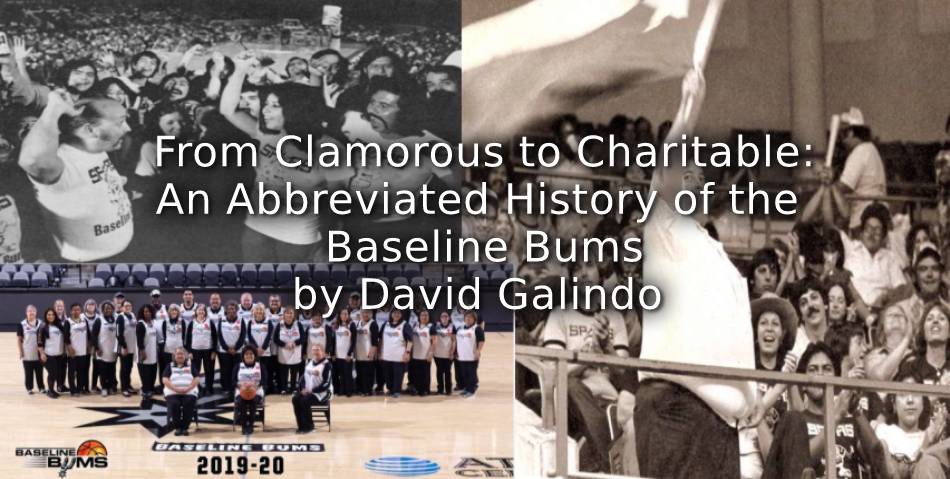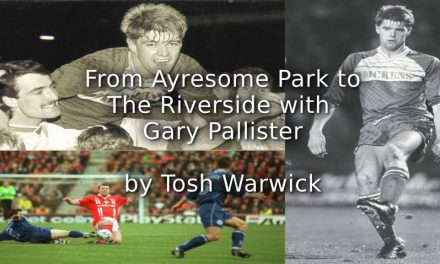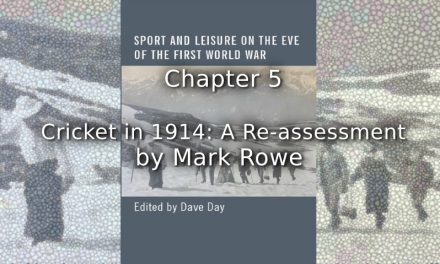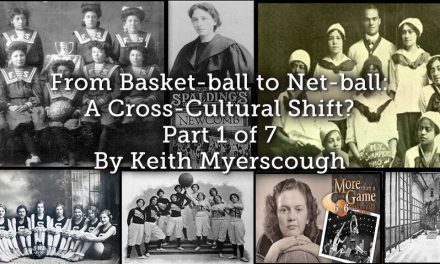On December 26th, 2020 for the first time in their history, the San Antonio Spurs of the National Basketball Association played a home opener without fans. Due to the COVID-19 pandemic, team officials disallowed fan entry for the community’s safety. Among the thousands of fans who usually attend Spurs home games is their official supporters’ group, the Baseline Bums. Founded in the same year as the team, 1973, they have been a consistent staple of organizational support. Before their first game, Spurs staffers Larry Braun and David Doyle recruited enthusiastic supporters of the San Antonio Missions minor league baseball team with the hopes they could provide energy and enthusiasm for the American Basketball Association’s newest franchise. The front office decided to charge Bums one dollar ticket admission prices and offered fans nickel beer nights. Not coincidentally, support for the team in HemisFair Arena came quickly. Baseline Bum Ronnie Jackson took advantage of offers such as these commenting he drank approximately fifteen beers per contest, an amount he considered quite conservative considering the alcohol intake of his cohorts. While the Baseline Bums now serve as community service ambassadors for the Spurs, this was not originally their role. For a time, the Baseline Bums acted as agents of autonomy and power, challenging the hegemony of the franchise, ABA, and NBA who attempted but often failed in their attempts to control the Bums’ behaviour.
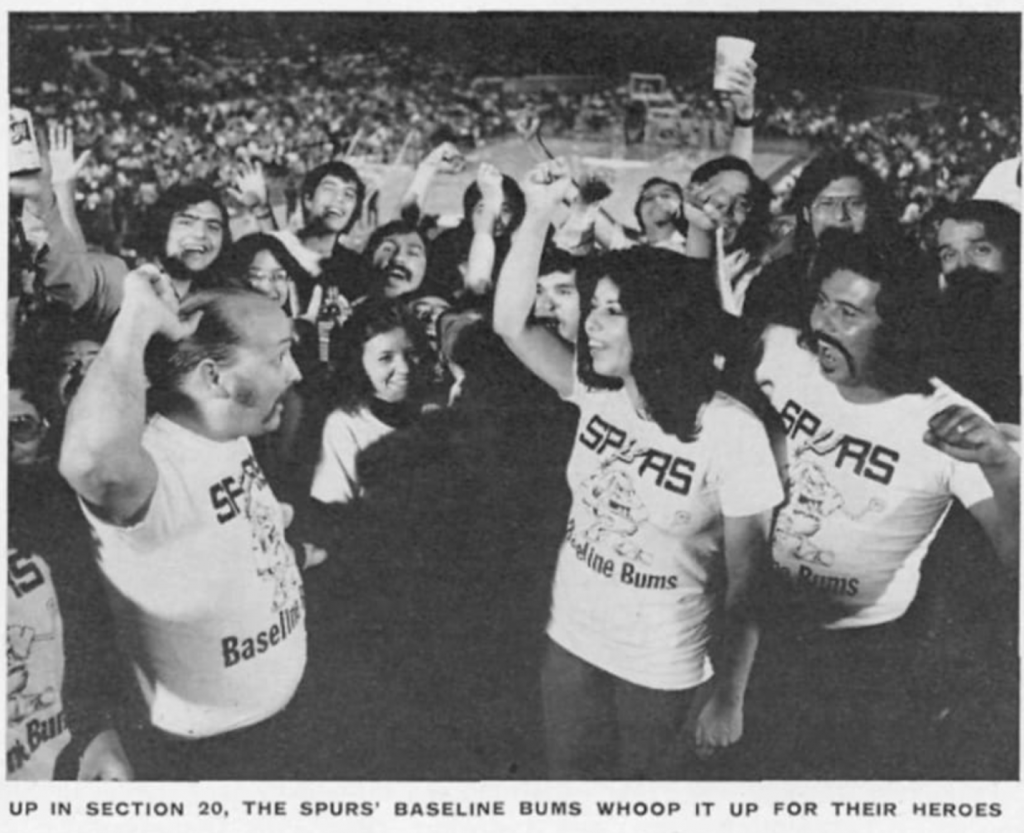
Baseline Bums Featured in Sports Illustrated, 1975
Courtesy of SI Vault
Early on the Baseline Bums asserted themselves as a force to be reckoned with often exhibiting the capacity to disrupt the hegemony of the Spurs franchise and the respective leagues they competed in. Longtime opponent Ron Boone loathed playing in San Antonio and envied how the Bums gave “everybody the business” over several years. Journalists covered the Bums often, usually for their distasteful escapades. One of the earlier antics represented in the newspapers was their treatment of Denver Nuggets Head Coach Larry Brown in 1975. In the days leading up to a Spurs vs. Nuggets match-up Brown commented, “the only thing good about San Antonio is the guacamole salad.” Come game time, the Bums and other fans in HemisFair Arena hurled avocadoes and guacamole at him, perhaps as a way to defend the legitimacy of their city and themselves even if it may have had the opposite effect. The Bums struck again in the 1976 ABA semi-finals for which journalists dubbed the “Easter Day Massacre” and “Basketbrawl” between the Spurs and New York Nets. During the player melee George Valle, who became the group’s long-time-leader, hurled his beer at Net Rich Jones who then chased Valle up the arena’s steps. Fellow Bums and friends affectionately monikered Valle “Big George” due to his rather large frame and his successful retreat up the stands that night became known as “Big George’s Miracle Run” with at least one person suggesting Valle’s actions contributed to the Spurs extending that series. Over the next two decades, Valle would only miss a handful of games as Bums President. Following his death in 2015, former Spur George Gervin and other friends noted his loyalty to the team and commemorated him as the “King of the Baseline Bums.” In 1995 Valle explained, “Spurs basketball is the only thing I live for. I just want to see them win one championship before I die. Then I can leave this world happy.” He would eventually see the team win five championships, but those would come well after his reign as the Bums’ “King” ended.
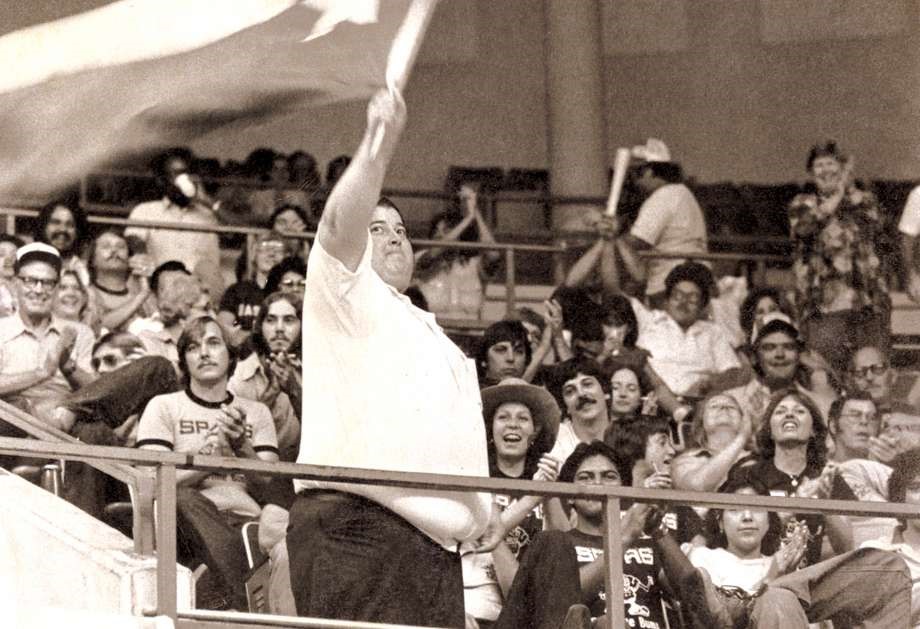
George Valle Waving the Texas Flag:
Courtesy of San Antonio Express-News
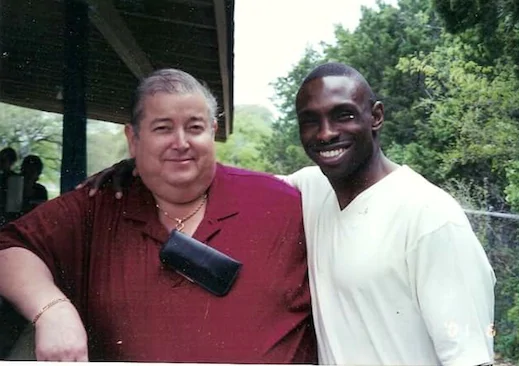
“Big George” Valle Later in Life with Spurs Point Guard Avery Johnson:
Courtesy of San Antonio Express-News
The autonomy the Bums enjoyed in the ABA carried over into the NBA after the leagues merged in 1976. Despite the NBA’s emphasis on order, the Bums dissented and gained national attention over the proceeding years. One such example was when Bums Ernest and Orfelinda Muñoz were married at centre court during halftime of a game and then held the reception at the stadium’s pavilion after the game’s conclusion. The Muñozes remained married until Ernest died in 2014. In their time as Bums they befriended Valle in what became a four-decade-long friendship that went beyond Spurs fandom. These types of relationships illustrate how loyalty to a team sustains over time. As initially the team is meaningful to the individual, through a shared experience of fandom that creates bonding, these relationships evolve to exist beyond the stadium while simultaneously incentivizing fans and friends to keep coming back to them as a rendezvous point. The Muñoz’s familial loyalty to the Spurs highlights another way devotion towards a team endures generationally. Tommy, the nephew of Orfelinda and Ernest, now carries on the tradition of being the family’s die-hard Spurs fan taking the place of his uncle who previously contributed to the “rowdiest” crowd in the league as the team’s “Dancing Harry.” Due to the contributions of the Muñozes and other Spurs supporters national journalists voted them as the worst behaved basketball fans in the United States and some of the unruliest in all of North American professional sports in 1980. Throughout the eighties, Sports Illustrated, CBS, the Washington Post, New York Times, Los Angeles Daily News, Denver Post, and others featured the Bums noting their heavy drinking and fierce passion for the Spurs with one journalist suggesting this group of supporters helped cultivate a “basketball-mad city” and became a civic institution nearly as important as the Spurs.
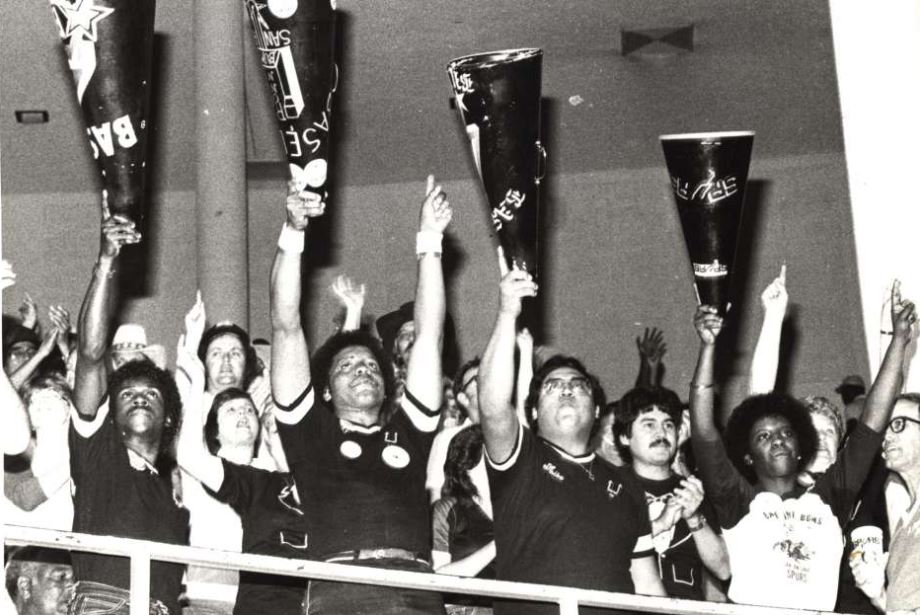
Left to Right: Baseline Bums Leon Gibson, Ronnie Jackson, Mike Gonzales, and Nina Johnson:
Courtesy of San Antonio Express-News
Throughout the eighties, the antics of the Bums continued featuring altercations with the likes of Larry Bird and Kareem Abdul-Jabbar. In 1980 a verbal confrontation turned physical outside of the arena amongst a few Bums and Celtic players. Bum Johnny Merla eventually filed an $825,000 lawsuit against Bird who he alleged assaulted him. Valle witnessed Bird strike Merla over the head with his duffel bag, but Bird’s legal team successfully argued it was in self-defence. In 1983 Jabbar labelled Bums’ actions as “tasteless” after they waved melted vinyl records in his direction in the wake of his Bel Air mansion burning to the ground and destroying his extensive jazz collection. The Bums also targeted lesser-known players such as Quintin Dailey a man charged with sexual assault in 1982. Leon Gibson, one of the more outlandish of the Bums, and others performed their interpretation of Dailey’s misconduct in the form of a skit on the court and throughout the stands. Several years later Gibson hurled a cow tongue at the rising star Michael Jordan due to his habit of playing with his out during games. The only penalty placed on Gibson for his tomfoolery was a public scolding from the Spurs General Manager. Over two decades the Bums cultivated an idiosyncratic reputation and atmosphere in and beyond HemisFair Arena as Bums, fans, players, and staffers often consociated and formed friendships as shown through the recollections of former Spurs such as George Karl and George Gervin. As the nineties commenced, the Bums reign of autonomy ended as they were pacified by several forces. In 1993 the Spurs left the tight confines of HemisFair Arena for the cavernous Alamodome. No longer were the Bums seated in section twenty situated directly above the opponent’s tunnel but instead were relocated much farther and higher from the court. Along with stadium gentrification and the NBA’s attempts to coerce a type of spectator conformity and order, what once was a peculiar and clamorous supporters’ group transformed into something else.
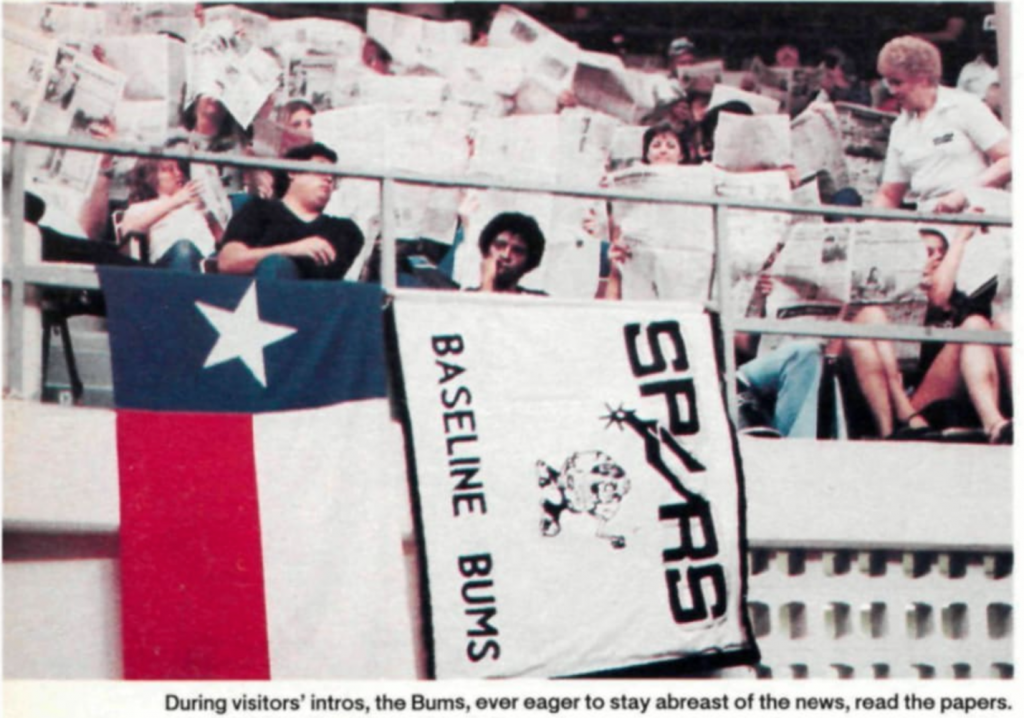
Baseline Bums Reading Newspapers During Opponents’ Introductions 1982:
Courtesy of Sports Illustrated
CBS Sports Feature on the Baseline Bums, 1983, as seen on YouTube
There were early signs as to what the Bums would eventually become. In the days of Valle, the Bums worked with a local high school and a cancer research centre to raise funds for respective causes as forms of charity. Now these actions are the Bums’ primary focus and function. Over the last forty-eight years, the Bums evolved from a clamorous beer-guzzling autonomous lot into a tamed community service outreach wing of the organization. Now comprised of a majority of women, as franchise ambassadors, they work with a multitude of non-profit organizations distinguishing themselves from their predecessors as a force of a different kind. While still proud of their contributions in the stadium, their community service appears paramount. History teaches us things change over time and power shifts- as illustrated here with the Baseline Bums. However, the larger point lurking is how history and life, especially given the current state of affairs, forces us to consider the temporality of all things; so perhaps when a relationship withstands a test of time, it should be recorded. For nearly half a century, where there were Spurs, there were Baseline Bums. Witnessing one without the other for the first time in history as we have during this raging pandemic could be a temporary hiccup or a type of foreshadowing. As the cartel that is North American professional sports moves onward, the threat of franchise relocation holds civic leaders and fanbases hostage to the whims of owners and leagues regardless of their historical linkages. This sentiment is not exclusive to the sporting world. The uncertainty of tomorrow provides us with an appreciation and even yearning for the past. This is why it is so important for historians to represent it and the people who lived it.
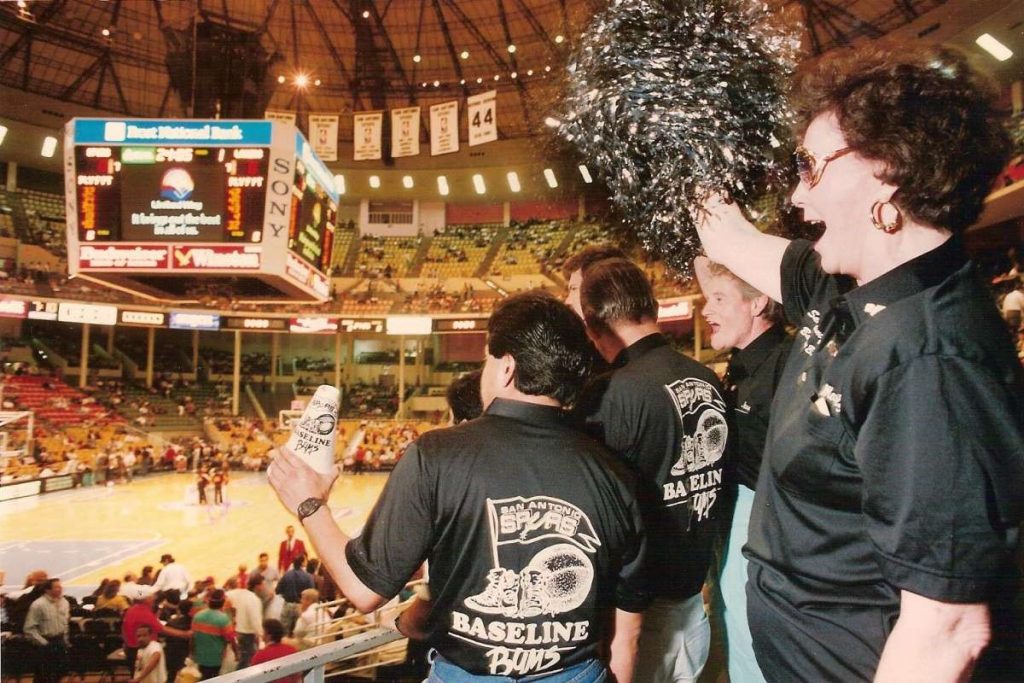
Baseline Bums in HemisFair Arena:
Courtesy of San Antonio Express-News
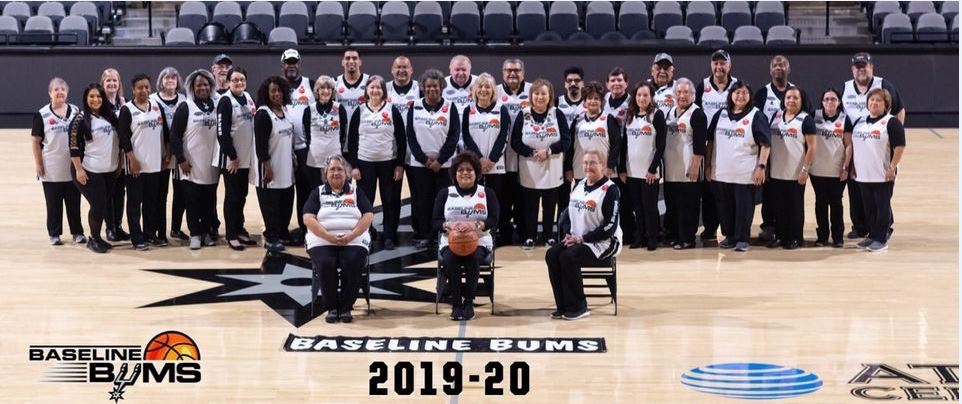
The Baseline Bums of the 2019-2020 Season:
Courtesy of Baseline Bums Facebook Pag
Article © David Galindo

